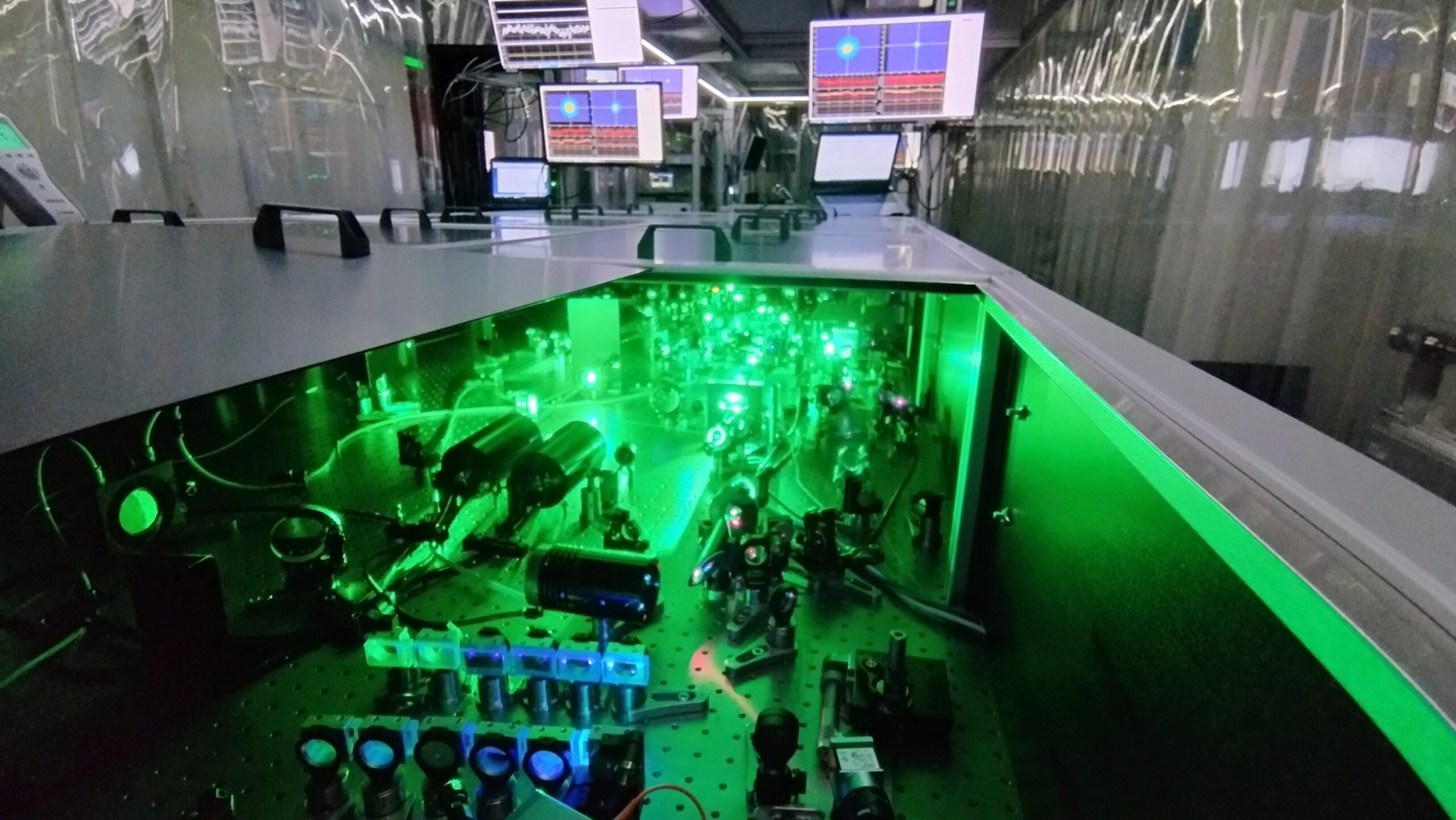MBI (Berlin, Germany)
Max Born Institute for Nonlinear Optics and Short Pulse Spectroscopy
MBI conducts basic research in nonlinear optics, ultrafast dynamics, the interaction of matter with laser light, and into the resulting applications. It develops and utilizes ultrashort and ultrafast lasers and laser-based short-pulse light sources in a wide spectral range in conjunction with nonlinear spectroscopy methods, as well as combining lasers with x-ray pulses from free electron lasers and synchrotrons.

Research highlights
Laser Development
A table-top midwave-infrared OPCPA system generates few-cycle pulses with multi-10 GW peak power at a 1 kHz repetition rate. The system utilizes ZnGeP2 nonlinear crystals and a highly stable 2 µm picosecond pump laser based on Ho:YLF. An excellent energy extraction is achieved, resulting in 3.4 mJ idler pulses at a center wavelength of 4.9 µm. Pulses as short as 80 fs are generated, close to only five optical cycles.
The system represents record parameters for high-energy OPCPAs beyond 4 µm wavelength [Opt. Lett. 45, 5998 (2020)]. The midwave OPCPA is applied, among others, as driver for hard X-ray generation. For this purpose the 5 μm pulses are focused to a 20 µm spot diameter onto a 20 µm thick Cu tape target resulting an unprecedented flux of up to 1.5 x 109 X-ray photons/shot. [Opt. Lett. 46, 210 (2021)]

High power 100kHz OPCPA in the NIR. Credit: Federico Furch
The pump-to-signal energy conversion efficiency in OPCPAs is limited by saturation and back-conversion, i.e., energy flowing from the idler and the amplified signal, to the pump. Moreover, saturation and back-conversion occur at different rates for different frequencies and positions over the spatial distribution, introducing strong spatio-temporal aberrations that severely limit the achievable peak intensity of the amplified signal pulses. A high-power two-stage OPCPA is demonstrated where the second stage incorporates a simple method to shape the pump beam into a flat-top profile. Flat-top pumping allows achieving efficient pump-to-signal conversion efficiency while minimizing spatio-temporal distortions due to back-conversion. The system delivers few-cycle pulses at 800 nm, with 40 W average power at 100 kHz. [Submitted to Opt. Express]
Magnetization Dynamics
Ultrafast magnetization dynamics is probed using extreme ultraviolet radiation between 35 eV and 200 eV, covering the M edges of transition metals as well as the N edges of rare earth metals. The radiation is generated using high harmonic generation either using 800 nm laser light derived from a Ti:Al2O3 laser amplifier or using 2 µm light derived from an optical parametric amplifier [Opt. Express 28, 8724 (2020)]
We offer a variety of experimental geometries, including transverse, longitudinal and polar magneto-optical Kerr spectroscopy in reflection, as well as magnetic circular dichroism in transmission geometry.
For more information on our instruments and experimental methods, please refer to the following recent publications: [Rev. Sci. Instrum. 91, 093001 (2020)]; [Phys. Rev. B 109, 184440 (2024)]; [Phys. Rev. B 111, 214423 (2025)]; [Phys. Rev. Research 4, L022062 (2022)]
Employing the emission from a laser-dirven plasma X-ray source (PXS) [Rev. Sci. Instrum. 94, (2023)], soft X-rays between 500-1500 eV can be employed for different resonant (magnetic) scattering [Optica 8, 1237 (2021), Light sci. appl., in press, (2025)] and spectroscopy experiments [Optica 10, 450 (2023)].
Ultrafast Electron Diffraction Imaging of Structural Dynamics
Sub-40-fs (RMS) electron pulses, generated via RF compression and characterised by THz streaking, are synchronised to the laser oscillator with sub-12-fs (RMS) timing jitter correction. This makes the UED instrument at MBI one of the brightest electron beams in Europe. With direct electron detection and operation at 40-100 kHz, we have demonstrated single-electron sensitivity in time-resolved diffraction, including measurements of thermal phonon dynamics in aluminium thin films at 30 kHz. These results, along with the characterisation and description of our state-of-the-art UED instrument, are detailed in our recent publication [Struct. Dyn. 11, 054302 (2024)]. We anticipate gas-phase capabilities soon.

All-attosecond transient absorption and reflectivity spectroscopy
We have recently demonstrated all-attosecond transient absorption (AATAS) spectroscopy in atoms, molecules and solids. To this end, intense attosecond pulses are generated using an 18-m-long high-harmonic generation (HHG) beamline. Research highlights include the real-time observation of electron-valence motion in atoms, the study of nonadiabatic dynamics near conical intersections in organic molecules as well as the investigation of core-exciton dynamics in dielectrics. In addition, we perform studies on the thermalization dynamics and the decay of inner-shell vacancies in metals and semiconductors making use of all-attosecond reflectivity spectroscopy (AATRS).
Ultrafast X-ray Diffraction – Investigation of Structural Dynamics
X-ray diffraction with a femtosecond time resolution allows for following structural dynamics of matter on atomic length and time scales, providing both transient atomic positions and the spatial distribution of electronic charge. MBI has pioneered ultrafast x-ray powder diffraction, applying an optical pump – hard x-ray probe approach with a time resolution of 100 fs. A laser-driven table-top x-ray source working at a 1 kHz repetition rate provides synchronized x-ray pulses at a photon energy of 8.04 keV (Cu Ka) with an unprecedented total flux of 1012 photons/s. [Phys.Rev. B 107, L180303 (2023)]
Expertise
Development of ultrashort and ultra-intense pulsed laser sources and laser-driven secondary radiation sources in a broad spectral range. Development of instrumentation and methods allowing to apply these sources in different research areas, ranging from atomic, molecular, and cluster physics to the physics of condensed matter, including magnetic materials and biological structures. Main research areas include attosecond physics, strong field physics and ultrafast phenomena in condensed matter.
Equipment offered to external users
- The BLiX laboratory offers a combination of laser-driven X-ray sources with state-of-the-art equipment for X-ray applications in microscopy, materials characterization and spectroscopy.
- An OPCPA delivering sub-10 fs pulses at 800 nm with 40 W average power at 100 kHz. Additional post-compression to sub-2 cycles is also available. The high repetition rate (100 kHz) OPCPA is combined with a COLTRIMS detector.
- High harmonic beamlines offering a diverse range of output parameters
- The NanoMovie application laboratory offers the possibility to conduct pump-probe ϑ–2ϑ reflectometry and spectroscopy experiments on solid-state materials, both in transmission and specular reflection geometry for ϑ angles between 0 and 45° with respect to the sample plane. The laser system operates at 10 kHz rep. rate and delivers 27 fs pulses at 2.1 µm, used both as a pump and to generate a soft X-Ray probe via HHG. The broadband HHG spectra reach up to 600 eV (source photon flux ≈109 photons/eV/s @ 150 eV, ≈106 photons/eV/s @ 450 eV). The possibility of pumping with tunable pulses in the NIR-UV region is currently under development.
- An ultrafast electron diffraction (UED) instrument has been built in 2021 and provides sub-40-fs (RMS) RF-compressed electrons with RF-laser timing jitter correction to sub-12-fs (RMS). It employs direct electron detection and operates between 1 Hz – 2 MHz (often at 40-100 kHz) with a wide-range of optical pump capabilities. The MBI UED instrument is the state-of-the-art in the UED field, and UED measurements in crystalline solid thin films (<100 nm) and gas-phase molecules are possible.
- Solid high-harmonic generation beamline. This beamline is based on a 100 kHz dual-beam ultrafast OPCPA system providing synchronized signal (1.5 µm) and idler (3.4 µm) pulses for time-resolved studies of strong-field-driven dynamics and high-harmonic generation (HHG) in solids. The system offers exceptional long-term stability, enabling extensive multi-parameter scans over several days. The setup allows generation and detection of high harmonics from solid targets in both reflection and transmission geometries. Various spectrometers and polarization optics permit intensity-, time-, and polarization-resolved HHG spectroscopy on semiconductors, strongly correlated, and other quantum materials. Additional modules support time-resolved absorption and reflectivity experiments. A dedicated Mach–Zehnder interferometric branch enables phase-resolved HHG interferometry using either the signal or the idler beam to probe sub-cycle phase delays in solid HHG. A custom-developed control and acquisition software ensures flexible operation and reproducibility across different experimental modes.
- Laser-driven plasma X-ray source (500-1500 eV) for resonant magnetic scattering and spectroscopy experiments. The soft X-ray pulse duration of < 9 ps and the available 2 ps, 1030 nm and 40 fs, 800 nm optical lasers enable a variety of excitation conditions and due to electronic synchronisation delays of up to 10 ms are possible. The experimental chamber provides magnetic fields of up to 1.5 T (rotatable within the scattering plane) and cryogenic sample temperatures of down to 30 K. A rotatable in-vacuum CCD and an on-vacuum fast-read-out hybrid-pixel detector enable reflection and transmission geometry for the soft-X-ray detection.
- High-energy few-cycle midwave and longwave OPCPA are available. The midwave OPCPA serves as driver for hard X-ray generation which can be used for X-ray diffraction pump-probe measurements. The OPCPA beyond 10 µm wavelength is a unique tool for nonlinear vibrational spectroscopy of liquids and solids.
